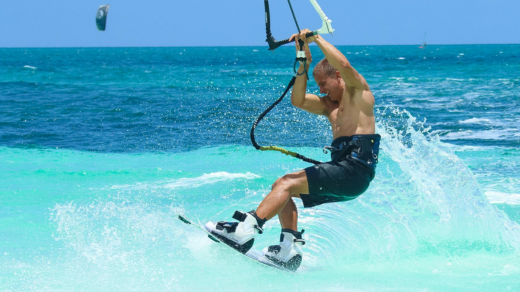
Aluminum vs. Carbon Foil Masts: Which One Is Right for You?
When it comes to hydrofoiling, whether for wingfoiling, kitefoiling, or surf foiling, selecting the right mast can significantly impact your performance and overall experience on the water. The two most common materials used for foil masts are aluminum and carbon fiber, each offering distinct advantages and trade-offs. Understanding these differences is essential to choosing the mast that best suits your style, skill level, and budget. In this guide, we’ll explore the key characteristics of aluminum and carbon foil masts, helping you make an informed decision on which one is the best fit for you.
For high-quality watersports accessories, including aluminum and carbon foil masts, explore top gear that aligns with your needs and skill level. The right equipment can transform your ride, making every session on the water more enjoyable and efficient.
Understanding the Role of the Foil Mast
Before diving into material comparisons, it’s important to understand the role of the foil mast. Positioned between the board and the front and rear wings, the mast determines how your hydrofoil performs in various conditions. A well-designed mast provides stability, minimizes drag, and allows for efficient energy transfer, ensuring a smoother ride. The mast also plays a crucial role in responsiveness, flex, and durability—all factors that influence the rider’s control and comfort on the water.
Aluminum Foil Masts: Durable and Affordable
Aluminum foil masts have been a staple in the watersports industry for years. They are popular among beginners and intermediate riders, as well as those looking for a budget-friendly option without sacrificing performance.
Advantages of Aluminum Foil Masts
- Affordability – One of the biggest advantages of aluminum masts is their cost-effectiveness. Compared to carbon fiber, aluminum is significantly cheaper, making it an excellent option for those just getting into hydrofoiling or looking for a reliable mast without a hefty price tag.
- Durability and Strength – Aluminum masts are known for their robustness. They can withstand impacts better than carbon fiber, making them a solid choice for riders who frequent shallow waters or those who might experience occasional crashes while learning.
- Ease of Maintenance – Aluminum is relatively easy to maintain and repair. Minor scratches or dings won’t compromise its integrity, and many aluminum masts come with modular designs, allowing for easy replacement of individual components if needed.
- Good Stiffness for Beginners – While not as stiff as carbon fiber, aluminum provides a moderate level of rigidity that helps stabilize the foil, making it easier for new riders to learn and progress.
Disadvantages of Aluminum Foil Masts
- Heavier Weight – One of the most notable downsides of aluminum is its weight. Aluminum masts are considerably heavier than their carbon counterparts, which can affect maneuverability and increase fatigue over longer sessions.
- Less Responsive – Due to its weight and flex properties, aluminum does not offer the same responsiveness as carbon fiber. Riders seeking high-performance turns, rapid feedback, or ultra-efficient pumping may find aluminum limiting.
- Corrosion Concerns – While aluminum is resistant to corrosion, it is not completely immune, especially in saltwater environments. Proper rinsing and maintenance are required to prevent oxidation and prolong the mast’s lifespan.
Carbon Foil Masts: High Performance and Lightweight
For those looking for top-tier performance, carbon fiber foil masts are the gold standard. Designed with advanced riders in mind, carbon masts offer unmatched stiffness, speed, and responsiveness, making them a favorite for racers and dedicated foilers.
Advantages of Carbon Foil Masts
- Ultra-Lightweight – Carbon fiber is significantly lighter than aluminum, making it easier to maneuver and reducing fatigue during extended sessions. This weight reduction translates into a more agile and responsive ride.
- Superior Stiffness and Control – Carbon fiber is known for its incredible rigidity, which minimizes flex and enhances control. This results in better energy transfer, making turns sharper and pumping more efficient.
- Enhanced Speed and Glide – Due to its reduced drag and increased responsiveness, carbon fiber allows for higher speeds with less effort. This makes it the preferred choice for racing, advanced wingfoiling, and high-performance surfing.
- Longer Lifespan – Unlike aluminum, carbon fiber does not corrode, making it an excellent long-term investment. With proper care, a carbon mast can last for years without significant wear and tear.
Disadvantages of Carbon Foil Masts
- High Cost – The biggest drawback of carbon fiber is its price. Carbon foil masts are considerably more expensive than aluminum ones, making them less accessible for beginners or casual riders.
- Brittleness Under Impact – While carbon fiber is extremely strong, it is also more brittle than aluminum. High-impact crashes, especially in shallow water, can lead to cracks or fractures that may require costly repairs or complete replacements.
- Less Forgiving for Beginners – Because of its stiffness and sensitivity, carbon fiber can be less forgiving for new riders. Beginners might find the responsiveness challenging, as it requires more refined control and technique.
Which One Should You Choose?
The decision between aluminum and carbon foil masts ultimately depends on your experience level, performance needs, and budget. Here’s a breakdown of which material suits different types of riders:
- Beginners & Casual Riders: If you’re just starting out or hydrofoiling recreationally, an aluminum mast is the best choice. Its affordability, durability, and ease of use make it ideal for learning and everyday riding.
- Intermediate Riders: If you’re progressing and want better performance without a massive price jump, a high-quality aluminum mast or a hybrid setup (carbon front wing with an aluminum mast) can provide a balance between cost and efficiency.
- Advanced & Competitive Riders: If you’re chasing high speeds, efficiency, and precision, a carbon foil mast is the way to go. Its lightweight and stiffness make it the superior option for performance-oriented foiling, whether in racing, surf foiling, or wingfoiling at a high level.
Final Thoughts on Choosing the Right Mast
Selecting the right foil mast is a crucial step in optimizing your hydrofoiling experience. While aluminum masts offer excellent durability and affordability, they come with added weight and slightly reduced responsiveness. Carbon masts, on the other hand, deliver top-tier performance with unparalleled stiffness and lightness but come at a higher price point.
Ultimately, the best mast for you depends on your goals and how you plan to use it. Whether you’re just starting out or pushing the limits of hydrofoiling, understanding the trade-offs between aluminum and carbon fiber will help you make an informed decision. Investing in the right mast ensures you get the most enjoyment and performance out of your foiling sessions.
